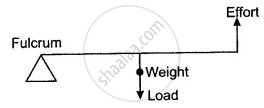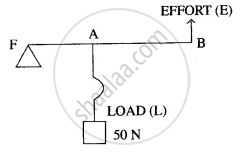Advertisements
Advertisements
प्रश्न
State the principle of a lever?
उत्तर
A lever works on the principle of moments. For an ideal lever, it is assumed that the lever is weightless and frictionless. In the equilibrium position of the lever, by the principle of moments,
Moment of load about the fulcrum = Moment of effort about the fulcrum.
Load × Load arm = Effort × Effort arm
APPEARS IN
संबंधित प्रश्न
Draw a diagram of a lever which is always used as a force multiplier. How is the effort arm related to the load arm in such a lever?
Which class of lever found in the human body is being used by a boy when he holds a load on the palm of his hand.
Which class of lever found in the human body is being used by a boy when he raises the weight of his body on his toes?
The following belong to which class of lever?
An oar of a boat
The following belong to which class of lever?
Pliers Tools
The following belong to which class of lever?
Wheelbarrow
The following belong to which class of lever?
Knife
When we want to use a machine as a force multiplier, which class of lever should we preferably use? Give a simple diagram of such a lever.

The diagram below shows a lever in use.

(i) To which class of lever does it belong?
(ii) If FA = 40 cm, AB = 60 cm, then find the mechanical advantage of the lever.
What is a lever?
